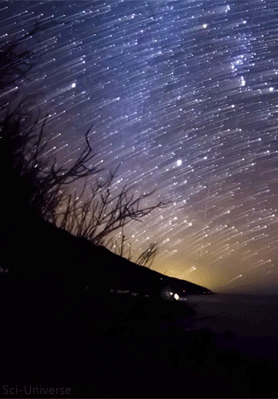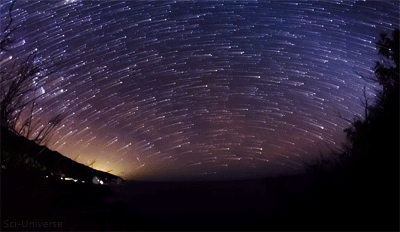Making A Spectacle Of Star Formation In Orion

Making a Spectacle of Star Formation in Orion
Looking like a pair of eyeglasses only a rock star would wear, this nebula brings into focus a murky region of star formation. NASA’s Spitzer Space Telescope exposes the depths of this dusty nebula with its infrared vision, showing stellar infants that are lost behind dark clouds when viewed in visible light.
Best known as Messier 78, the two round greenish nebulae are actually cavities carved out of the surrounding dark dust clouds. The extended dust is mostly dark, even to Spitzer’s view, but the edges show up in mid-wavelength infrared light as glowing, red frames surrounding the bright interiors. Messier 78 is easily seen in small telescopes in the constellation of Orion, just to the northeast of Orion’s belt, but looks strikingly different, with dominant, dark swaths of dust. Spitzer’s infrared eyes penetrate this dust, revealing the glowing interior of the nebulae.
Credit: NASA/JPL/Spitzer
More Posts from Night-hides-the-world and Others
Solar System 10 Things: Looking Back at Pluto
In July 2015, we saw Pluto up close for the first time and—after three years of intense study—the surprises keep coming. “It’s clear,” says Jeffery Moore, New Horizons’ geology team lead, “Pluto is one of the most amazing and complex objects in our solar system.”
1. An Improving View

These are combined observations of Pluto over the course of several decades. The first frame is a digital zoom-in on Pluto as it appeared upon its discovery by Clyde Tombaugh in 1930. More frames show of Pluto as seen by the Hubble Space Telescope. The final sequence zooms in to a close-up frame of Pluto taken by our New Horizons spacecraft on July 14, 2015.
2. The Heart

Pluto’s surface sports a remarkable range of subtle colors are enhanced in this view to a rainbow of pale blues, yellows, oranges, and deep reds. Many landforms have their own distinct colors, telling a complex geological and climatological story that scientists have only just begun to decode. The image resolves details and colors on scales as small as 0.8 miles (1.3 kilometers). Zoom in on the full resolution image on a larger screen to fully appreciate the complexity of Pluto’s surface features.
3. The Smiles

July 14, 2015: New Horizons team members Cristina Dalle Ore, Alissa Earle and Rick Binzel react to seeing the spacecraft’s last and sharpest image of Pluto before closest approach.
4. Majestic Mountains

Just 15 minutes after its closest approach to Pluto, the New Horizons spacecraft captured this near-sunset view of the rugged, icy mountains and flat ice plains extending to Pluto’s horizon. The backlighting highlights more than a dozen layers of haze in Pluto’s tenuous atmosphere. The image was taken from a distance of 11,000 miles (18,000 kilometers) to Pluto; the scene is 780 miles (1,250 kilometers) wide.
5. Icy Dunes

Found near the mountains that encircle Pluto’s Sputnik Planitia plain, newly discovered ridges appear to have formed out of particles of methane ice as small as grains of sand, arranged into dunes by wind from the nearby mountains.
6. Glacial Plains

The vast nitrogen ice plains of Pluto’s Sputnik Planitia – the western half of Pluto’s “heart”—continue to give up secrets. Scientists processed images of Sputnik Planitia to bring out intricate, never-before-seen patterns in the surface textures of these glacial plains.
7. Colorful and Violent Charon

High resolution images of Pluto’s largest moon, Charon, show a surprisingly complex and violent history. Scientists expected Charon to be a monotonous, crater-battered world; instead, they found a landscape covered with mountains, canyons, landslides, surface-color variations and more.
8. Ice Volcanoes

One of two potential cryovolcanoes spotted on the surface of Pluto by the New Horizons spacecraft. This feature, known as Wright Mons, was informally named by the New Horizons team in honor of the Wright brothers. At about 90 miles (150 kilometers) across and 2.5 miles (4 kilometers) high, this feature is enormous. If it is in fact an ice volcano, as suspected, it would be the largest such feature discovered in the outer solar system.
9. Blue Rays

Pluto’s receding crescent as seen by New Horizons at a distance of 120,000 miles (200,000 kilometers). Scientists believe the spectacular blue haze is a photochemical smog resulting from the action of sunlight on methane and other molecules in Pluto’s atmosphere. These hydrocarbons accumulate into small haze particles, which scatter blue sunlight—the same process that can make haze appear bluish on Earth.
10. Encore

On Jan. 1, 2019, New Horizons will fly past a small Kuiper Belt Object named MU69 (nicknamed Ultima Thule)—a billion miles (1.5 billion kilometers) beyond Pluto and more than four billion miles (6.5 billion kilometers) from Earth. It will be the most distant encounter of an object in history—so far—and the second time New Horizons has revealed never-before-seen landscapes.
Make sure to follow us on Tumblr for your regular dose of space: http://nasa.tumblr.com.


Venezuela by Jonas Piontek
Enchanted Moon II by Nima Shayesteh
Wolf Moon by miguel aviles - Art of Visuals Collective
Moon on the horizon, Santa Barbara | California (by A. Klioutchnikov)
And unfortunately I can’t find credit for the final photo.




Nobody better slam my girl Hubble Telescope after the Webb Telescope pics came out, alright? For YEARS she was the baddest bitch around and we owe her nothing but gratitude
More than Just Dust in the Wind

From space, we can see a swirling brown mass making its way across the Atlantic – dust from the Sahara Desert – the largest hot desert in the world. It’s a normal phenomenon. Every year, winds carry millions of tons of dust from North Africa, usually during spring and summer in the Northern Hemisphere.

June 2020 has seen a massive plume of dust crossing the ocean. It’s so large it’s visible from one million miles away in space.

Dust clouds this large can affect air quality in regions where the dust arrives. The particles can also scatter the Sun’s light, making sunrises and sunsets more vibrant.

Dust particles in the air are also known as aerosols. We can measure aerosols, including dust, sea salt and smoke, from satellites and also use computer models to study how they move with the wind.

Following the transport of dust from space shows us how one of the driest places on Earth plays a role in fertilizing the Amazon rainforest. There are minerals in Saharan dust, like phosphorous, that exist in commercial fertilizers, helping seed the rainforest.

Make sure to follow us on Tumblr for your regular dose of space: http://nasa.tumblr.com



Geminid meteor shower of 2012, here’s the full video.
Image: Jack Hughes /Twitter: @jackmrhughes

#ScienceIsCool #WeAreTheUniverse #StarSeed #Universe #Beyond #Space
-
 enchantdspace reblogged this · 8 years ago
enchantdspace reblogged this · 8 years ago -
 enchantdspace reblogged this · 8 years ago
enchantdspace reblogged this · 8 years ago -
 ghoulish-n-foolish liked this · 10 years ago
ghoulish-n-foolish liked this · 10 years ago -
 thissometimepoet liked this · 10 years ago
thissometimepoet liked this · 10 years ago -
 waking-dawn reblogged this · 10 years ago
waking-dawn reblogged this · 10 years ago -
 mysticalstreamsalutations reblogged this · 10 years ago
mysticalstreamsalutations reblogged this · 10 years ago -
 mysticalstreamsalutations liked this · 10 years ago
mysticalstreamsalutations liked this · 10 years ago -
 night-hides-the-world reblogged this · 10 years ago
night-hides-the-world reblogged this · 10 years ago -
 blackholesinmyhead-blog liked this · 10 years ago
blackholesinmyhead-blog liked this · 10 years ago -
 skybluefantasy reblogged this · 10 years ago
skybluefantasy reblogged this · 10 years ago -
 thomasbolt reblogged this · 10 years ago
thomasbolt reblogged this · 10 years ago -
 collidingnebulas reblogged this · 10 years ago
collidingnebulas reblogged this · 10 years ago -
 vicahro reblogged this · 10 years ago
vicahro reblogged this · 10 years ago -
 ultraminiimus reblogged this · 10 years ago
ultraminiimus reblogged this · 10 years ago -
 cryingpan liked this · 10 years ago
cryingpan liked this · 10 years ago -
 amoralbottom liked this · 10 years ago
amoralbottom liked this · 10 years ago -
 kimest01 liked this · 10 years ago
kimest01 liked this · 10 years ago -
 legacyofinsanity reblogged this · 10 years ago
legacyofinsanity reblogged this · 10 years ago -
 legacyofinsanity liked this · 10 years ago
legacyofinsanity liked this · 10 years ago -
 gatewaytoinfinity reblogged this · 10 years ago
gatewaytoinfinity reblogged this · 10 years ago -
 zexapher liked this · 10 years ago
zexapher liked this · 10 years ago -
 lumberjackindisguise reblogged this · 10 years ago
lumberjackindisguise reblogged this · 10 years ago -
 ultraminiimus liked this · 10 years ago
ultraminiimus liked this · 10 years ago -
 puzzlingdaydream liked this · 10 years ago
puzzlingdaydream liked this · 10 years ago -
 hellocaptainsarah reblogged this · 10 years ago
hellocaptainsarah reblogged this · 10 years ago -
 userfromspace reblogged this · 10 years ago
userfromspace reblogged this · 10 years ago -
 mostunlikelytosucceed reblogged this · 10 years ago
mostunlikelytosucceed reblogged this · 10 years ago -
 mostunlikelytosucceed liked this · 10 years ago
mostunlikelytosucceed liked this · 10 years ago -
 tiremat liked this · 10 years ago
tiremat liked this · 10 years ago -
 deaths-reject66 liked this · 10 years ago
deaths-reject66 liked this · 10 years ago -
 p90hex reblogged this · 10 years ago
p90hex reblogged this · 10 years ago -
 amiable-microbe reblogged this · 10 years ago
amiable-microbe reblogged this · 10 years ago -
 hopefulstarlightdaze reblogged this · 10 years ago
hopefulstarlightdaze reblogged this · 10 years ago -
 alexfuckingturner reblogged this · 10 years ago
alexfuckingturner reblogged this · 10 years ago -
 crednescodpeace liked this · 10 years ago
crednescodpeace liked this · 10 years ago -
 thomasbolt liked this · 10 years ago
thomasbolt liked this · 10 years ago -
 needsmorestartrek-blog liked this · 10 years ago
needsmorestartrek-blog liked this · 10 years ago -
 exxxxxxxxxxxxmortis reblogged this · 10 years ago
exxxxxxxxxxxxmortis reblogged this · 10 years ago
Astronomy and the other wonders you witness when you look to the skies.
115 posts


